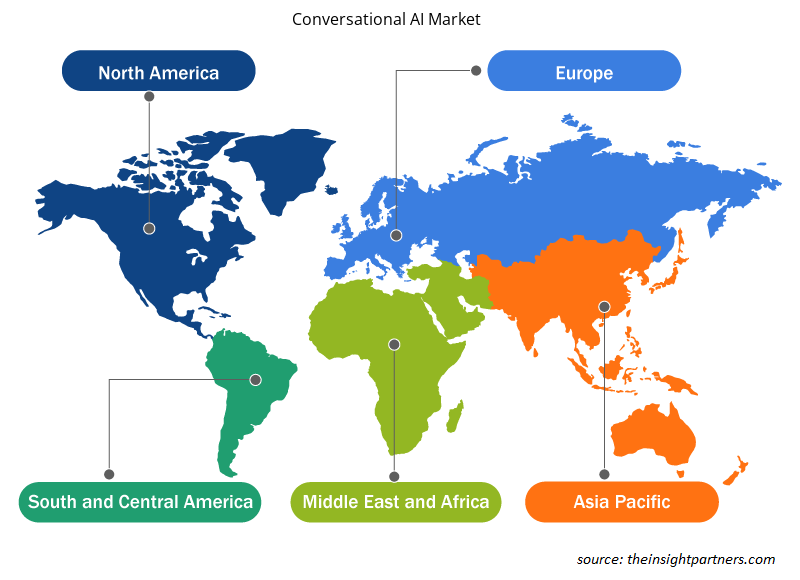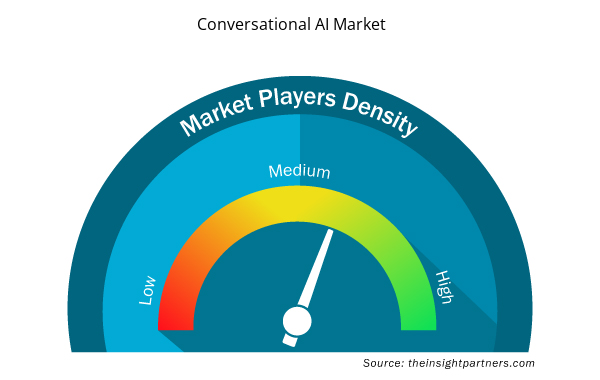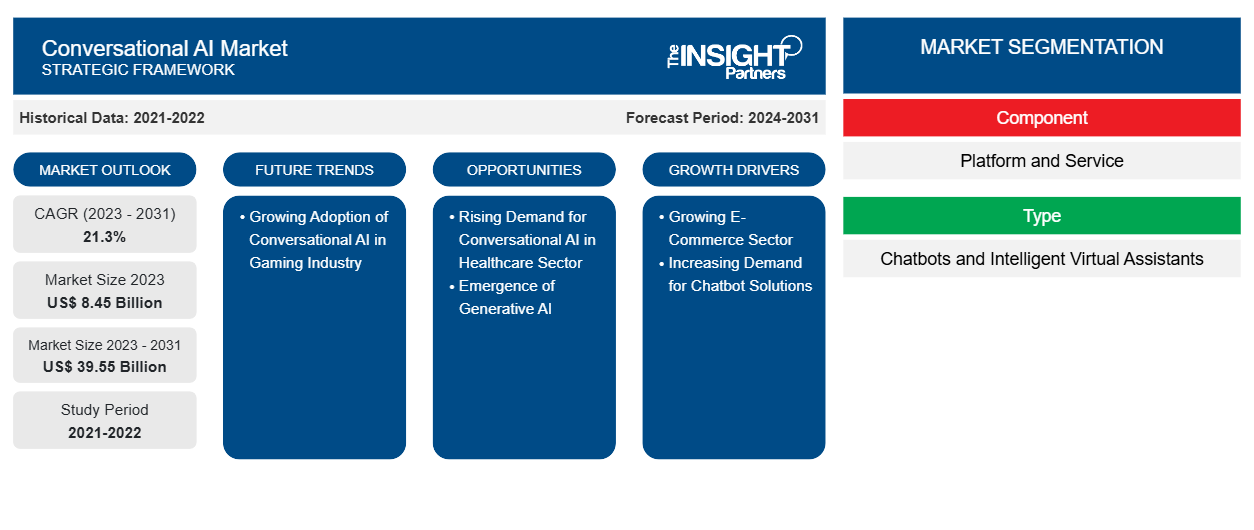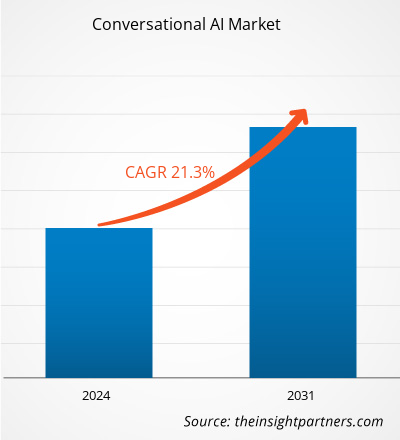من المتوقع أن يصل حجم سوق الذكاء الاصطناعي التحادثي إلى 39.55 مليار دولار أمريكي بحلول عام 2031 من 8.45 مليار دولار أمريكي في عام 2023. ومن المتوقع أن يسجل السوق معدل نمو سنوي مركب بنسبة 21.3٪ من عام 2023 إلى عام 2031. ومن المرجح أن يظل التبني المتزايد للذكاء الاصطناعي التحادثي في صناعة الألعاب اتجاهًا رئيسيًا في السوق خلال فترة التنبؤ.CAGR of 21.3% from 2023 to 2031. The growing adoption of conversational AI in the gaming industry is likely to remain a key market trend during the forecast period.
تحليل سوق الذكاء الاصطناعي المحادثة
إن الطلب المتزايد وانخفاض تكاليف تطوير برامج المحادثة الآلية، وخدمات دعم العملاء التي تعمل بالذكاء الاصطناعي، والنشر متعدد القنوات، كلها عوامل تدفع نمو سوق الذكاء الاصطناعي التحادثي . وهناك العديد من مشاريع التطوير الجارية لضمان استخدام هذه التقنيات بشكل فعال وكفء لحالات الاستخدام المؤسسية التي تعالج قضايا الأعمال الحقيقية. ومن أجل الاستفادة من قدرة الذكاء الاصطناعي على الاستجابة بطريقة محادثة مثل الإنسان، ظهرت عدد من شركات الذكاء الاصطناعي التوليدي. ولديها القدرة على تغيير كيفية تفاعل الناس مع التكنولوجيا تمامًا من خلال تسهيل محادثات أكثر بساطة وشبيهة بالإنسان ومصممة لتناسب الاحتياجات والتفضيلات الفردية. وعلاوة على ذلك، أصبح استخدام منصات الذكاء الاصطناعي التحادثي شائعًا بين مؤسسات القطاع العام حيث تعمل الحكومات في جميع أنحاء العالم على السماح بالتحول الرقمي على نطاق واسع وإعادة اختراع تجربة المواطن، مما يعزز نمو السوق.
نظرة عامة على سوق الذكاء الاصطناعي التحادثي
يشير الذكاء الاصطناعي التحادثي إلى التكنولوجيا التي يمكن للمستهلكين التفاعل معها مثل برامج المحادثة أو الوكلاء الافتراضيين. فهي تحاكي التفاعلات البشرية من خلال تحديد مدخلات الكلام والنص؛ وترجمة معانيها عبر عدة لغات؛ واستخدام كميات هائلة من البيانات والتعلم الآلي (ML) ومعالجة اللغة الطبيعية (NLP). يمزج الذكاء الاصطناعي التحادثي بين تقنيات معالجة اللغة الطبيعية والتعلم الآلي مع الأنواع التقليدية الثابتة من التكنولوجيا التفاعلية مثل برامج المحادثة. ومن خلال التفاعلات التي تشبه تلك التي تتم مع الوكلاء البشريين القياسيين، يتم استخدام هذا المزيج للرد على المستهلكين.
قم بتخصيص هذا التقرير ليناسب متطلباتك
ستحصل على تخصيص لأي تقرير - مجانًا - بما في ذلك أجزاء من هذا التقرير، أو تحليل على مستوى الدولة، وحزمة بيانات Excel، بالإضافة إلى الاستفادة من العروض والخصومات الرائعة للشركات الناشئة والجامعات
- احصل على أهم اتجاهات السوق الرئيسية لهذا التقرير.ستتضمن هذه العينة المجانية تحليلاً للبيانات، بدءًا من اتجاهات السوق وحتى التقديرات والتوقعات.
محركات وفرص سوق الذكاء الاصطناعي التحادثي
قطاع التجارة الإلكترونية المتنامي يحرك سوق الذكاء الاصطناعي للمحادثة
منذ جائحة كوفيد-19، كان هناك ارتفاع في التسوق عبر الإنترنت في جميع أنحاء العالم. وفقًا لاتحاد النقل الجوي الدولي (IATA)، في عام 2021، اشترى 2.14 مليار شخص (أي حوالي 27.6٪ من سكان العالم) منتجات من بوابات الإنترنت. بالإضافة إلى ذلك، تقود منطقة آسيا والمحيط الهادئ سوق التجارة الإلكترونية العالمية، حيث تمثل الصين نسبة كبيرة من نمو السوق الإقليمية. وفقًا لإدارة التجارة الدولية، تعد الصين أكبر سوق للتجارة الإلكترونية في جميع أنحاء العالم، حيث تولد حوالي 50٪ من معاملات العالم. في عام 2021، حققت البلاد حوالي 1.5 تريليون دولار أمريكي من الإيرادات من خلال قطاع التجارة الإلكترونية، لتصبح أكبر سوق للتجارة الإلكترونية في العالم. كما تعد أوروبا منطقة رئيسية تدعم نمو التجارة الإلكترونية. وفقًا لـ Eurostat، في عام 2022، استخدم 91٪ من الأشخاص الذين تتراوح أعمارهم بين 16 و 74 عامًا في دول الاتحاد الأوروبي الإنترنت، حيث طلب حوالي 75٪ منهم سلعًا أو خدمات عبر الإنترنت. كما ارتفعت نسبة المتسوقين عبر الإنترنت إلى 75% في عام 2022 من 55% في عام 2012، بزيادة قدرها 20% على مدى العقد الماضي. يفضل العديد من المتسوقين في أوروبا منصات التسوق عبر الإنترنت مثل أمازون وتارجت وول مارت، مما يدفع بشكل كبير نمو قطاع التجارة الإلكترونية في أوروبا. يؤدي الطلب المتزايد على التسوق عبر الإنترنت إلى زيادة الطلب على التجارة التفاعلية. تعمل روبوتات التسوق الذكية التي تعمل بالذكاء الاصطناعي على إحداث ثورة في صناعة التجارة الإلكترونية من خلال التفاعل مع عملائها وتقديم إرشادات شخصية وزيادة المبيعات. أيضًا، من خلال الاستفادة من التعلم الآلي ومعالجة اللغة الطبيعية، يساعد الذكاء الاصطناعي التفاعلي في إشراك حوارات هادفة وفهم احتياجات العملاء ورعاية العملاء المحتملين في الوقت الفعلي. وبالتالي، فإن قطاع التجارة الإلكترونية المتنامي يدفع نمو سوق الذكاء الاصطناعي التفاعلي.
ظهور الذكاء الاصطناعي التوليدي لتقديم فرص للسوق خلال فترة التوقعات
إن الذكاء الاصطناعي التوليدي مهم للغاية في مجموعة واسعة من الشركات. إن قدرته على توليد محتوى فريد له تداعيات مهمة في الصناعات مثل الفن والتصميم والتسويق. تعمل هذه التكنولوجيا على تحسين التخصيص والابتكار وتبسيط العمليات الإبداعية. علاوة على ذلك، من خلال إنتاج سيناريوهات وإجابات مختلفة، يساعد الذكاء الاصطناعي التوليدي في حل المشكلات. وبالتالي، فهو يظهر كأداة رئيسية تعمل على تحويل المنهجيات التقليدية وتفتح إمكانيات جديدة حيث تحاول الصناعات إدراك إمكانات الابتكار المدفوع بالذكاء الاصطناعي. بالإضافة إلى ذلك، يتفوق الذكاء الاصطناعي التوليدي في أتمتة الأنشطة المتكررة، مما يحرر الموارد البشرية لمشاريع أكثر استراتيجية وتعقيدًا. كما أنه يوفر تجارب شخصية للغاية من خلال توفير معلومات المنتج حسب الأذواق الفردية. من الحملات التسويقية المخصصة إلى اقتراحات المنتج المنسقة، تستخدم تقنية الذكاء الاصطناعي التوليدي البيانات لإنتاج محتوى يتواصل مع كل مستخدم. يعمل دمج الذكاء الاصطناعي التوليدي في روبوتات الدردشة الذكية والمساعدين الافتراضيين على تحسين قدرتهم على المشاركة في محادثات طبيعية تشبه الإنسان. تفسر هذه الأنظمة مدخلات المستخدم وتعالجها لإنتاج استجابات واقتراحات وحلول في الوقت الفعلي. إن الذكاء الاصطناعي التوليدي يمكّن روبوتات الدردشة من تقديم المشورة المخصصة وإدارة الاستفسارات الصعبة. وهذا يحول خدمة العملاء والتفاعلات في التجارة الإلكترونية وغيرها من المجالات حيث يكون التواصل الفعال أمرًا بالغ الأهمية. وعلاوة على ذلك، تعمل تقنية الذكاء الاصطناعي التوليدي على تحويل عالم معالجة اللغة، مما يسمح بالترجمات الدقيقة والتفاعلات الطبيعية التي تتجاوز حدود الاتصالات التقليدية. وتوضح تطبيقاتها في ترجمة اللغة والتفاعلات مع روبوتات الدردشة القوة الثورية لتكنولوجيا الذكاء الاصطناعي المتطورة عبر مجموعة واسعة من القطاعات. وبالتالي، من المتوقع أن يؤدي ظهور الذكاء الاصطناعي التوليدي إلى تغذية نمو سوق الذكاء الاصطناعي التحادثي خلال الفترة المتوقعة.
تقرير تحليل تجزئة سوق الذكاء الاصطناعي التحادثي
إن القطاعات الرئيسية التي ساهمت في استخلاص تحليل سوق الذكاء الاصطناعي التحادثي هي المكون والنوع ونوع النشر والصناعة.
- بناءً على المكون، ينقسم السوق إلى منصة وخدمة. يهيمن قطاع المنصة على السوق في عام 2023.
- بناءً على النوع، يتم تقسيم السوق إلى روبوتات الدردشة والمساعدين الافتراضيين الأذكياء . سيطر قطاع روبوتات الدردشة على السوق في عام 2023.
- من حيث نوع النشر، يتم تقسيم سوق الذكاء الاصطناعي التحادثي إلى محلي وسحابي. سيطر قطاع المحلي على السوق في عام 2023.
- بناءً على الصناعة، يتم تقسيم السوق إلى تجارة التجزئة والتجارة الإلكترونية، والرعاية الصحية وعلوم الحياة، والسفر والضيافة، والخدمات المصرفية والمالية والتأمين، وتكنولوجيا المعلومات والاتصالات، والإعلام والترفيه، وغيرها. هيمن قطاع تجارة التجزئة والتجارة الإلكترونية على السوق في عام 2023.
تحليل حصة سوق الذكاء الاصطناعي التحادثي حسب المنطقة الجغرافية
- تم تقسيم سوق الذكاء الاصطناعي التحادثي إلى خمس مناطق رئيسية - أمريكا الشمالية وأوروبا وآسيا والمحيط الهادئ (APAC) والشرق الأوسط وأفريقيا (MEA) وأمريكا الجنوبية والوسطى. سيطرت أمريكا الشمالية على السوق في عام 2023، تليها أوروبا ومنطقة آسيا والمحيط الهادئ.
- استحوذت أمريكا الشمالية على أكبر حصة سوقية في عام 2023. ويشهد السوق في المنطقة نموًا قويًا بسبب التبني الواسع النطاق للتقنيات المبتكرة والحاجة المتزايدة بسرعة إلى خدمات دعم العملاء المدعومة بالذكاء الاصطناعي. بالإضافة إلى ذلك، تستثمر غالبية الشركات في أمريكا الشمالية في الابتكارات التكنولوجية لتلبية احتياجات عملائها وتجاوزها. كما أن الوعي الصحي المتزايد بين السكان يدفع نمو سوق الذكاء الاصطناعي التحادثي في المنطقة. تقود صناعة الرعاية الصحية في أمريكا الشمالية الطريق في دمج الروبوتات والذكاء الاصطناعي والواقع الافتراضي والواقع المعزز.
رؤى إقليمية حول سوق الذكاء الاصطناعي التحادثي
لقد قام المحللون في Insight Partners بشرح الاتجاهات والعوامل الإقليمية المؤثرة على سوق الذكاء الاصطناعي التحادثي طوال فترة التوقعات بشكل شامل. يناقش هذا القسم أيضًا قطاعات سوق الذكاء الاصطناعي التحادثي والجغرافيا في جميع أنحاء أمريكا الشمالية وأوروبا ومنطقة آسيا والمحيط الهادئ والشرق الأوسط وأفريقيا وأمريكا الجنوبية والوسطى.

- احصل على البيانات الإقليمية المحددة لسوق الذكاء الاصطناعي المحادثة
نطاق تقرير سوق الذكاء الاصطناعي التحادثي
| سمة التقرير | تفاصيل |
|---|---|
| حجم السوق في عام 2023 | 8.45 مليار دولار أمريكي |
| حجم السوق بحلول عام 2031 | 39.55 مليار دولار أمريكي |
| معدل النمو السنوي المركب العالمي (2023 - 2031) | 21.3% |
| البيانات التاريخية | 2021-2022 |
| فترة التنبؤ | 2024-2031 |
| القطاعات المغطاة | حسب المكون
|
| المناطق والدول المغطاة | أمريكا الشمالية
|
| قادة السوق وملفات تعريف الشركات الرئيسية |
|
كثافة اللاعبين في سوق الذكاء الاصطناعي التحادثي: فهم تأثيرها على ديناميكيات الأعمال
يشهد سوق الذكاء الاصطناعي التحادثي نموًا سريعًا، مدفوعًا بالطلب المتزايد من المستخدم النهائي بسبب عوامل مثل تفضيلات المستهلكين المتطورة والتقدم التكنولوجي والوعي المتزايد بفوائد المنتج. ومع ارتفاع الطلب، تعمل الشركات على توسيع عروضها والابتكار لتلبية احتياجات المستهلكين والاستفادة من الاتجاهات الناشئة، مما يؤدي إلى زيادة نمو السوق.
تشير كثافة اللاعبين في السوق إلى توزيع الشركات أو المؤسسات العاملة في سوق أو صناعة معينة. وهي تشير إلى عدد المنافسين (اللاعبين في السوق) الموجودين في مساحة سوق معينة نسبة إلى حجمها أو قيمتها السوقية الإجمالية.
الشركات الرئيسية العاملة في سوق الذكاء الاصطناعي المحادثة هي:
- أمازون دوت كوم المحدودة
- شركة الآلات التجارية الدولية
- شركة ألفابيت
- شركة أوراكل
- ساب اس اي
- شركة مايكروسوفت
إخلاء المسؤولية : الشركات المذكورة أعلاه ليست مرتبة بأي ترتيب معين.

- احصل على نظرة عامة على أهم اللاعبين الرئيسيين في سوق الذكاء الاصطناعي التحادثي
أخبار سوق الذكاء الاصطناعي المحادثة والتطورات الأخيرة
يتم تقييم سوق الذكاء الاصطناعي التحادثي من خلال جمع البيانات النوعية والكمية بعد البحث الأولي والثانوي، والذي يتضمن منشورات الشركات المهمة وبيانات الجمعيات وقواعد البيانات. فيما يلي بعض التطورات في سوق الذكاء الاصطناعي التحادثي:
- أعلنت شركة Amazon.com، Inc. عن التوفر العام لخدمة Amazon Q للشركات والمطورين. تعد خدمة Amazon Q المساعد التوليدي الأكثر قدرة والمدعوم بالذكاء الاصطناعي لتسريع تطوير البرامج والاستفادة من البيانات الداخلية للشركات.
(المصدر: أمازون، بيان صحفي، أبريل 2024)
- أطلقت شركة Wipro Limited منصة Wipro Enterprise Artificial Intelligence (AI)-Ready من خلال الاستفادة من منصات الذكاء الاصطناعي والبيانات watsonx من شركة International Business Machines Corp، بما في ذلك watsonx.ai وwatsonx.data وwatsonx.governance ومساعدي الذكاء الاصطناعي. تدعم هذه الشراكة شركة Wipro Limited لتقديم خدمة متوافقة للعملاء تساعد في تسريع تبني الذكاء الاصطناعي.
(المصدر: شركة آي بي إم، بيان صحفي، فبراير 2024)
تقرير سوق الذكاء الاصطناعي التحادثي: التغطية والنتائج المتوقعة
يوفر "حجم سوق الذكاء الاصطناعي المحادثة والتوقعات (2021-2031)" تحليلاً مفصلاً للسوق يغطي المجالات المذكورة أدناه:
- حجم سوق برامج تقدير التكلفة والتنبؤ به على المستويات العالمية والإقليمية والوطنية لجميع قطاعات السوق الرئيسية التي يغطيها النطاق
- اتجاهات سوق برامج تقدير التكلفة بالإضافة إلى ديناميكيات السوق مثل المحركات والقيود والفرص الرئيسية
- تحليل مفصل لـ PEST و SWOT
- تحليل سوق برامج تقدير التكلفة الذي يغطي اتجاهات السوق الرئيسية والإطار العالمي والإقليمي والجهات الفاعلة الرئيسية واللوائح والتطورات الأخيرة في السوق
- تحليل المشهد الصناعي والمنافسة الذي يغطي تركيز السوق، وتحليل خريطة الحرارة، واللاعبين البارزين، والتطورات الأخيرة لسوق الذكاء الاصطناعي التحادثي
- ملفات تعريف الشركة التفصيلية
- التحليل التاريخي (سنتان)، السنة الأساسية، التوقعات (7 سنوات) مع معدل النمو السنوي المركب
- تحليل PEST و SWOT
- حجم السوق والقيمة / الحجم - عالميًا وإقليميًا وقطريًا
- الصناعة والمنافسة
- مجموعة بيانات Excel



Report Coverage
Revenue forecast, Company Analysis, Industry landscape, Growth factors, and Trends

Segment Covered
This text is related
to segments covered.

Regional Scope
North America, Europe, Asia Pacific, Middle East & Africa, South & Central America

Country Scope
This text is related
to country scope.
الأسئلة الشائعة
Asia Pacific is anticipated to grow with the highest CAGR over the forecast period.
The key players holding majority shares in the conversational AI market are Amazon.com Inc, Alphabet Inc, International Business Machines Corp, Microsoft Corp, and Oracle Corp.
The conversational AI market is expected to reach US$ 39.55 million by 2031.
The US held the largest conversational AI market share in 2023.
The increase in demand for chatbot solutions and the growing e-commerce sector are the major factors that propel the conversational AI market.
The conversational AI market was estimated to be US$ 8.45 billion in 2023 and is expected to grow at a CAGR of 21.3% during the forecast period 2023 - 2031.
Growing adoption of conversational AI in gaming industry plays a significant role in the conversational AI market in the coming years.
The List of Companies - Conversational AI Market
- Amazon.com Inc
- International Business Machines Corp
- Alphabet Inc
- Oracle Corp
- SAP SE
- Microsoft Corp
- Artificial Solutions International AB
- Cognigy GmbH
- Kore.ai Inc.
- Rasa Technologies Inc
The Insight Partners performs research in 4 major stages: Data Collection & Secondary Research, Primary Research, Data Analysis and Data Triangulation & Final Review.
- Data Collection and Secondary Research:
As a market research and consulting firm operating from a decade, we have published and advised several client across the globe. First step for any study will start with an assessment of currently available data and insights from existing reports. Further, historical and current market information is collected from Investor Presentations, Annual Reports, SEC Filings, etc., and other information related to company’s performance and market positioning are gathered from Paid Databases (Factiva, Hoovers, and Reuters) and various other publications available in public domain.
Several associations trade associates, technical forums, institutes, societies and organization are accessed to gain technical as well as market related insights through their publications such as research papers, blogs and press releases related to the studies are referred to get cues about the market. Further, white papers, journals, magazines, and other news articles published in last 3 years are scrutinized and analyzed to understand the current market trends.
- Primary Research:
The primarily interview analysis comprise of data obtained from industry participants interview and answers to survey questions gathered by in-house primary team.
For primary research, interviews are conducted with industry experts/CEOs/Marketing Managers/VPs/Subject Matter Experts from both demand and supply side to get a 360-degree view of the market. The primary team conducts several interviews based on the complexity of the markets to understand the various market trends and dynamics which makes research more credible and precise.
A typical research interview fulfils the following functions:
- Provides first-hand information on the market size, market trends, growth trends, competitive landscape, and outlook
- Validates and strengthens in-house secondary research findings
- Develops the analysis team’s expertise and market understanding
Primary research involves email interactions and telephone interviews for each market, category, segment, and sub-segment across geographies. The participants who typically take part in such a process include, but are not limited to:
- Industry participants: VPs, business development managers, market intelligence managers and national sales managers
- Outside experts: Valuation experts, research analysts and key opinion leaders specializing in the electronics and semiconductor industry.
Below is the breakup of our primary respondents by company, designation, and region:

Once we receive the confirmation from primary research sources or primary respondents, we finalize the base year market estimation and forecast the data as per the macroeconomic and microeconomic factors assessed during data collection.
- Data Analysis:
Once data is validated through both secondary as well as primary respondents, we finalize the market estimations by hypothesis formulation and factor analysis at regional and country level.
- Macro-Economic Factor Analysis:
We analyse macroeconomic indicators such the gross domestic product (GDP), increase in the demand for goods and services across industries, technological advancement, regional economic growth, governmental policies, the influence of COVID-19, PEST analysis, and other aspects. This analysis aids in setting benchmarks for various nations/regions and approximating market splits. Additionally, the general trend of the aforementioned components aid in determining the market's development possibilities.
- Country Level Data:
Various factors that are especially aligned to the country are taken into account to determine the market size for a certain area and country, including the presence of vendors, such as headquarters and offices, the country's GDP, demand patterns, and industry growth. To comprehend the market dynamics for the nation, a number of growth variables, inhibitors, application areas, and current market trends are researched. The aforementioned elements aid in determining the country's overall market's growth potential.
- Company Profile:
The “Table of Contents” is formulated by listing and analyzing more than 25 - 30 companies operating in the market ecosystem across geographies. However, we profile only 10 companies as a standard practice in our syndicate reports. These 10 companies comprise leading, emerging, and regional players. Nonetheless, our analysis is not restricted to the 10 listed companies, we also analyze other companies present in the market to develop a holistic view and understand the prevailing trends. The “Company Profiles” section in the report covers key facts, business description, products & services, financial information, SWOT analysis, and key developments. The financial information presented is extracted from the annual reports and official documents of the publicly listed companies. Upon collecting the information for the sections of respective companies, we verify them via various primary sources and then compile the data in respective company profiles. The company level information helps us in deriving the base number as well as in forecasting the market size.
- Developing Base Number:
Aggregation of sales statistics (2020-2022) and macro-economic factor, and other secondary and primary research insights are utilized to arrive at base number and related market shares for 2022. The data gaps are identified in this step and relevant market data is analyzed, collected from paid primary interviews or databases. On finalizing the base year market size, forecasts are developed on the basis of macro-economic, industry and market growth factors and company level analysis.
- Data Triangulation and Final Review:
The market findings and base year market size calculations are validated from supply as well as demand side. Demand side validations are based on macro-economic factor analysis and benchmarks for respective regions and countries. In case of supply side validations, revenues of major companies are estimated (in case not available) based on industry benchmark, approximate number of employees, product portfolio, and primary interviews revenues are gathered. Further revenue from target product/service segment is assessed to avoid overshooting of market statistics. In case of heavy deviations between supply and demand side values, all thes steps are repeated to achieve synchronization.
We follow an iterative model, wherein we share our research findings with Subject Matter Experts (SME’s) and Key Opinion Leaders (KOLs) until consensus view of the market is not formulated – this model negates any drastic deviation in the opinions of experts. Only validated and universally acceptable research findings are quoted in our reports.
We have important check points that we use to validate our research findings – which we call – data triangulation, where we validate the information, we generate from secondary sources with primary interviews and then we re-validate with our internal data bases and Subject matter experts. This comprehensive model enables us to deliver high quality, reliable data in shortest possible time.


 احصل على عينة مجانية لهذا التقرير
احصل على عينة مجانية لهذا التقرير